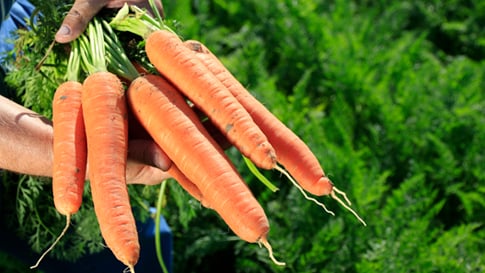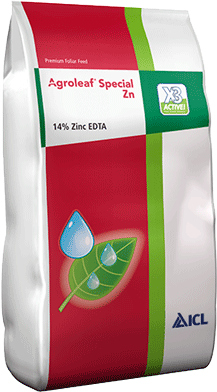Growing Carrots
Crop Nutrition Advice
Everything you need to know about carrot fertilization, best practice, suitable products, field trials and more.
Advice for growing Carrot (Daucus carota)

Carrots harvested in optimum condition

Growing carrots
Carrot Production and Nutrition Overview
Origin and Crop Types
- Historical Background:
Carrots (Daucus carota) are believed to have originated in Central Asia (particularly Afghanistan), with early varieties being purple or yellow. These spread to Europe and eventually gave rise to the predominant orange carrot, developed by Dutch breeders in the 16th and 17th centuries. - Varieties:
- Eastern Carrots: Typically purple or yellow, grown mainly in Central and South Asia.
- Western Carrots: Predominantly orange, red, or white, widely cultivated worldwide.
- Wild Relatives: The wild carrot (Daucus carota subsp. carota), native to Europe and Asia, is the ancestor of modern domesticated carrots.
Nutritional Benefits
- Human Nutrition:
Carrots are an excellent source of beta-carotene, which the body converts to vitamin A (1). Adequate intake supports eye health, immune function, and skin integrity. They are also high in dietary fiber and contain antioxidants that may reduce risks of certain chronic diseases. - Animal Nutrition:
When fed in moderation, carrots can be a valuable supplement in livestock rations, providing energy and vitamins. Overfeeding may lead to digestive imbalances. - Potential Hazards:
Excessive consumption can cause carotenemia (a harmless skin yellowing). For animals, very high intake may result in digestive upset.
Economic Value
- To Producers:
Carrots can be a high-value crop with comparatively lower input costs relative to many other vegetables. Mechanized farming increases efficiency, and organic carrots often command premium prices due to consumer demand (2). - To Consumers:
Carrots are affordable, nutritious, and versatile, available year-round in most markets. Value-added products (e.g., baby carrots, carrot juice) also enjoy strong consumer interest.
World Production
- Geographic Distribution:
According to FAO data, China produces over 50% of the global carrot supply. Other major producers include the United States, Russia, and Uzbekistan (3). - Production Statistics:
Annual global production is about 45 million metric tons on 1.2 million hectares (3). - Yield Comparisons:
- Highest Yields: The Netherlands (~65 t/ha) and the United Kingdom (~60 t/ha).
- Lowest Yields: Some regions in Sub-Saharan Africa (~10–15 t/ha).
- Reasons for Differences:
- Varieties: High-yielding, disease-resistant cultivars well-adapted to local conditions.
- Technology: Mechanized planting, irrigation, harvesting, and precision agriculture.
- Agronomic Practices: Regular soil testing, balanced fertilization, and integrated pest management.
- Infrastructure: Efficient cold-chain and storage facilities minimize post-harvest losses.
Market Requirements by Segment
- Fresh Market: Uniform, smooth-skinned, bright orange roots.
- Processing: Stringent quality for baby food (e.g., low nitrates, low heavy metals, high beta-carotene).
- Organic Market: Rapidly expanding due to consumer interest in sustainability and reduced chemical inputs.
Agronomic Principles
- Growth Stages:
Carrots typically require 70–120 days from planting to maturity, progressing through germination, vegetative growth, root thickening, and final maturation (4). - Soil Preparation:
Best grown in well-drained sandy loam with pH 6.0–6.8. Deep tillage minimizes root malformation. - Planting Techniques:
Optimal spacing is ~5–7 cm between plants and 20–30 cm between rows, with seeds placed 1–2 cm deep. - Pest and Disease Management:
Common issues include carrot rust fly and Alternaria leaf blight. IPM and crop rotation are key control methods (4).
Factors Influencing Yield Quantity and Quality
- Climatic Factors:
Ideal temperatures range 15–21°C; excessive heat can cause bolting or poor root formation. - Soil and Water Management:
Consistent moisture is vital; uneven watering often leads to root cracking. - Stress Management:
Mulching helps conserve soil moisture and regulate soil temperature.
Role of Nutrients on Specific Traits
| Nutrient | Quantity Impact | Quality Impact | Tolerance/Stress Impact |
|---|---|---|---|
| N (Nitrogen) | Promotes vegetative growth and root size. Ensures adequate leaf area for photosynthesis and yield. | Excess N can cause elongated roots and reduced sugar content. | Improves vigor but excess may boost pest/disease susceptibility. |
| P (Phosphorus) | Supports early root and shoot establishment, aiding root formation. | Improves root structure, shape, and texture. | Helps reduce fungal disease susceptibility (root rots). |
| K (Potassium) | Enhances water-use efficiency and sugar translocation to roots. | Improves pigmentation, sugar content, and root firmness. | Increases tolerance to pests and drought stress. |
| Mg (Magnesium) | Key for chlorophyll synthesis, supporting strong growth. | Enhances carbohydrate metabolism and root development. | Reduces vulnerability to cavity spot. |
| Ca (Calcium) | Essential for root elongation and cell division. | Prevents disorders like cavity spot and root cracking. | Strengthens cell walls, reducing susceptibility to infections. |
| S (Sulfur) | Enhances protein synthesis and N-use efficiency. | Improves amino acid profiles, contributing to better flavor and appearance. | Helps combat soil-borne diseases. |
Nutrient Deficiency and Toxicity Symptoms
Macronutrients
- Nitrogen (N):
- Deficiency: Pale green/yellow older leaves, stunted growth.
- Toxicity: Excess leaf growth at the expense of root development; roots can be long and less sweet.
- Phosphorus (P):
- Deficiency: Purpling of leaves, stunted plants, reduced root size.
- Toxicity: Rare, but can cause micronutrient (Zn, Fe) imbalances.
- Potassium (K):
- Deficiency: Yellowing/scorching of leaf margins, reduced root quality and sugar content.
- Toxicity: Uncommon; may interfere with Mg uptake.
- Calcium (Ca):
- Deficiency: Cavity spot, splitting, and weak cell walls.
- Toxicity: Rare; often linked with high soil pH and micronutrient imbalances.
- Magnesium (Mg):
- Deficiency: Interveinal chlorosis on older leaves, reduced photosynthesis.
- Toxicity: Rare; can antagonize Ca and K uptake.
- Sulfur (S):
- Deficiency: General yellowing, reduced growth.
- Toxicity: Rare; typically soil-condition dependent.
Micronutrients
- Boron (B):
- Deficiency: Cracking, hollowing, discoloration of roots; stunted growth.
- Toxicity: Leaf burn, root growth suppression.
- Zinc (Zn):
- Deficiency: Interveinal chlorosis on younger leaves, stunting.
- Toxicity: Reduced root and leaf development.
- Iron (Fe):
- Deficiency: Interveinal chlorosis of younger leaves.
- Toxicity: Bronzing of leaves, potential root deformities.
- Manganese (Mn):
- Deficiency: Interveinal chlorosis, slow growth.
- Toxicity: Brown leaf spots, reduced photosynthesis.
- Copper (Cu):
- Deficiency: Wilting, leaf twisting, poor root quality.
- Toxicity: Stunted growth, dark green leaves.
Plant Nutrition Summary
- Macronutrients: Carrots have a high potassium demand, with moderate requirements for nitrogen and phosphorus.
- Micronutrients: Boron, zinc, and manganese are particularly important.
- Uptake Rates: On average, carrots absorb about:
- 90–120 kg/ha of N
- 50–70 kg/ha of P → 115–160 kg/ha of P₂O₅
- 150–200 kg/ha of K → 180–240 kg/ha of K₂O
Salinity, Sodicity, and Heavy Metal Concerns
- Salinity Issues:
- Carrots are moderately sensitive to salinity (yield reductions often start >2 dS/m) (5).
- Symptoms include poor germination, leaf burn, reduced sugar content.
- Mitigation: Adequate irrigation to leach salts; use of salt-tolerant cultivars if unavoidable.
- Sodicity Issues:
- High sodium degrades soil structure, impeding aeration and water infiltration.
- Sodium also inhibits Ca, Mg, and K uptake.
- Mitigation: Gypsum applications; routine soil testing for exchangeable sodium percentage (ESP).
- Heavy Metal Concerns:
- Cadmium (Cd): More soluble in acidic soils (pH < 5.5); can accumulate in roots.
- Lead (Pb): Industrial contamination or polluted irrigation water can elevate Pb in carrot peels.
- Arsenic (As): Found in some contaminated soils; uptake often worsened by waterlogging.
- Mitigation: Liming acidic soils; avoiding contaminated water/fertilizers; regular soil/irrigation monitoring (6).
Application Methods
- Delivery Systems: Drip irrigation minimizes nutrient leaching; foliar sprays correct micronutrient deficiencies.
- Timing: Split nitrogen applications between planting and root-thickening stages.
- Challenges: Uneven germination can complicate uniform nutrient distribution.
Soil and Plant Analysis
- Soil Testing: Essential to measure pH, organic matter, and key nutrients (e.g., boron, potassium).
- Plant Tissue Analysis: Typically done during early vegetative and mid-growth stages to fine-tune fertilization.
Fertilizer Application
| Growth Stage | Nitrogen (kg/ha) | Phosphorus (kg/ha) | Potassium (kg/ha) |
|---|---|---|---|
| Pre-Planting | 40 | 50 (≈115 P₂O₅) | 80 (≈96 K₂O) |
| Vegetative | 30 | 20 (≈46 P₂O₅) | 50 (≈60 K₂O) |
| Root Dev. | 20 | 0 | 70 (≈84 K₂O) |
Climate Expectations
- Optimal Conditions: Day temperatures of ~18–24°C and nights of ~10–15°C.
- Risks: High temperatures can cause premature bolting; excessive rainfall can lead to cracking.
- Adaptation Strategies: Raised beds to improve drainage; shade nets to mitigate heat stress where needed.
Additional Considerations
- Sustainability Practices:
Use of cover crops, crop rotation, and precision irrigation minimizes environmental impact and improves soil health (7). - Technology Integration:
Remote sensing and GPS-guided equipment can improve planting density, fertilizer efficiency, and pest scouting. - Post-Harvest Management:
Prompt cooling and storage at high humidity (e.g., 95–98% RH) can extend shelf life and preserve root quality.
Nutrient Removal Table
Below are approximate nutrient removal values for carrots, given per metric ton (fresh weight). Actual figures vary with variety, soil fertility, and cultural practices (4)(7).
| Carrot Part | N (kg/ton) | P₂O₅ (kg/ton) | K₂O (kg/ton) |
|---|---|---|---|
| Roots | 2.0–2.8 | 0.8–1.2 | 3.0–4.0 |
| Foliage | 2.5–3.5 | 0.9–1.3 | 3.5–4.5 |
Selected References
- USDA. (n.d.). National Nutrient Database for Standard Reference. https://www.usda.gov
- University of Georgia Extension. (2021). Commercial Carrot Production and Management.
- FAO. (2022). FAOSTAT – Crop Production Data. http://www.fao.org/faostat
- UC Davis Vegetable Research & Information Center. (n.d.). Carrot Production in California. https://vric.ucdavis.edu
- Texas A&M AgriLife Extension. (n.d.). Crop Salt Tolerance. https://agrilifeextension.tamu.edu
- Cornell University Cooperative Extension. (n.d.). Soil Contaminants and Best Practices for Healthy Gardens.
- Purdue University Extension. (n.d.). Vegetable Crops Hotline & Resources.









